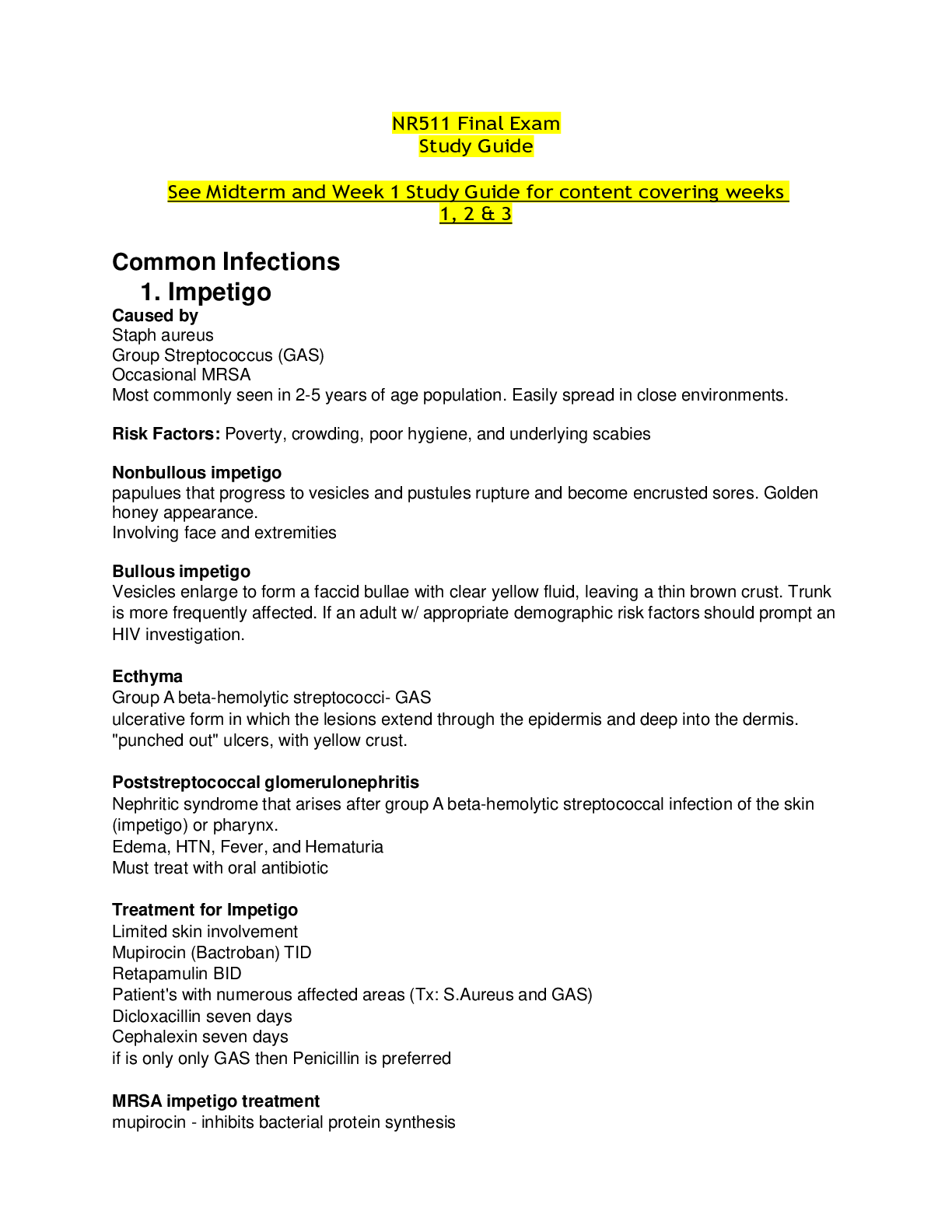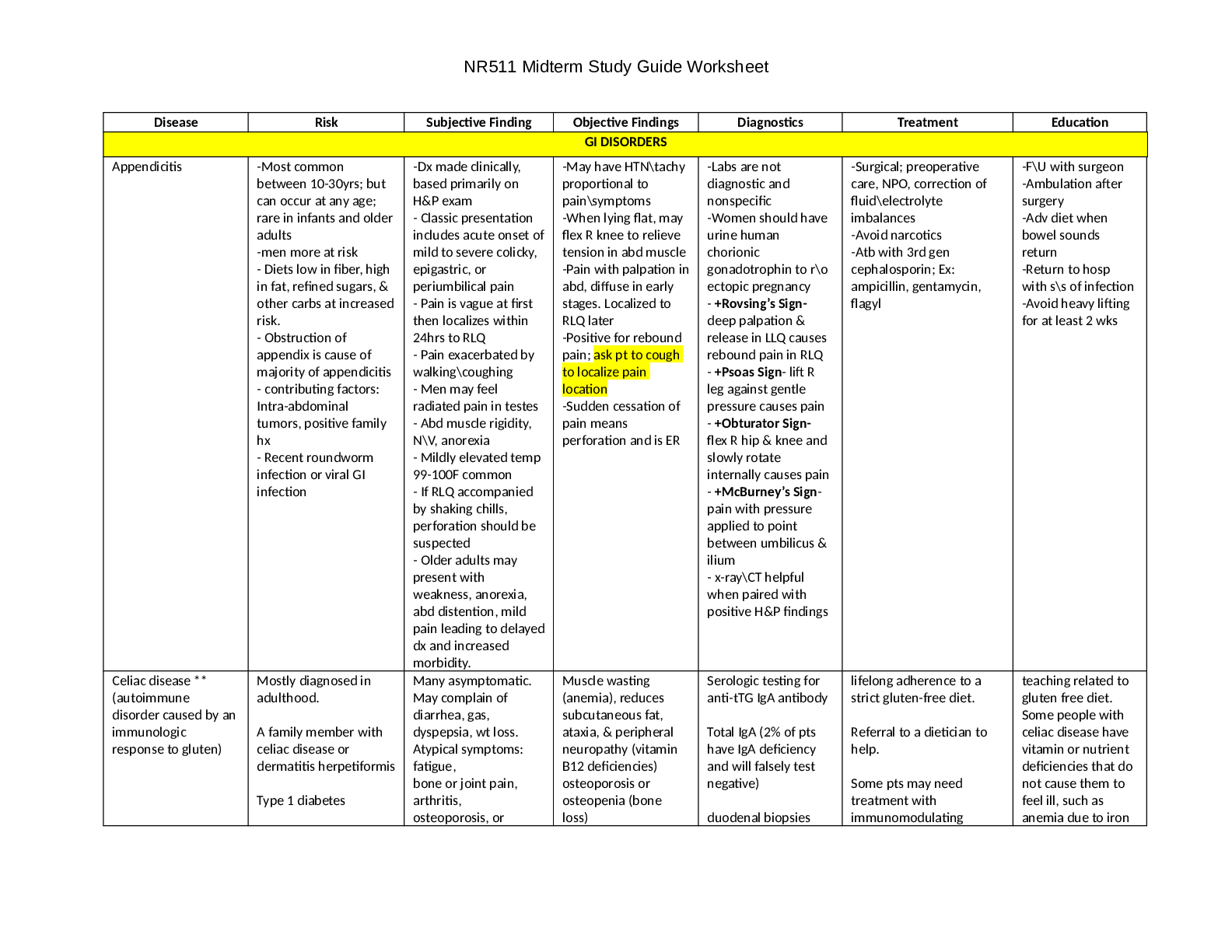*NURSING > STUDY GUIDE > NR 511 / NR511FINAL EXAM STUDY GUIDE (All)
NR 511 / NR511FINAL EXAM STUDY GUIDE
Document Content and Description Below
Week 5 Identify the population most commonly affected by bacterial prostatitis: Acute bacterial prostatitis occurs predominantly in sexually active men between the ages of 30 and 50 years old, wher... eas chronic bacterial prostatitis is most common in men older than 50. Prostatitis (Acute, chronic, nonbacterial) Risk factors Age> 50 yrs, Hx of prostate calculi, BPH, prev. UTI, recurrent UTIS acute and chronic-> strep. Faecalis and staph. Aureus are most common physical exam: abd. Exam to detect distended bladder, costovertebral angle tenderness, genital exam, digital rectal exam acute: warm, tense, swollen, boggy and very tender prostate vs chronic: normal or little boggy diagnostic testing: U/A (PYURIA + for all three), midstream urine cand s, 츛, urethral swab for GC AND CT, cystoscopy, transrectal ult Acute-- treatment 14 to 28 day regimen-cipro 500 mg q 12 hr, levofloxacin 500mg daily or doxycycline or TMPSMX STD coverage for ABP; single dose IM ceftriaxone 250 mg + single dose azithromycine or doXy 100 mg BID 7 D Supportive measure: antipyretics, nsaids, hydration, stool softeners Chronic-treatment 5 to 12 week antibiotic course with same meds + alpha-blocking agents to relax the smooth muscles around prostate Nonbacterial prostatitis- treatmentFEFER TO UROLOGIST Discuss the physical exam characteristics of acute bacterial prostatitis: urinary complains (frequency, urgency, nocturia, dysuria) pain & discomfort (LBP, penile, scrotal pain, fever, chills, malaise or painful ejaculation, arthralgia, myalgia) Chronic bacterial s/s: symptoms often absent, perineal pain, LBP, lower abd. Pain, scrotal or penile pain, pain with ejaculation, dysuria… Discuss how the Phren sign can differentiate between testicular torsion and epididymitis: The most common symptom in testicular torsion is sudden, severe pain accompanied by swelling of the affected testis. The patient may have pain for several days without seeking medical attention. The most common finding on clinical exam is the absence of the cremasteric reflex and unlike in epididymitis, elevation of the affected testis does not relieve the pain (negative Phren’s sign). Epididymitis Can affect any age in male, Hx of unprotected intercourse, a new sexual partner, Hx of UTI or urinary discharge Symptoms Unilateral scroll pain which radiates along the spermatic cord or to the flank HALLMARK SYMPTOM: RELIEF OF DISCOMFORT WITH ELEVATION OF TESTIS AND EPIDIDYMIS Tx: same antibiotics ceftriaxone 250mg IM TIMES 1 and azythromycine 1 gm po times 1 BPH Most common condition in males > 40 yrs Risk factors: ? Size does not correlated with severity of symptoms BPH= smooth and enlarged, if hard, suspect cancerTreatment Avoid caffeine and alcohol Conservative tx vs surgery Alpha blockers (relax smooth muscle)Tamsulosine 0.4-0.8mg qd, doxazosin 4-8 mg qd 5-alpha-reductade inhibitors finasteride 5mg qd or dutasteride 0.5 mg qd Testicular torsion- twisting or rotation of the testes around the spermatic cord, blocking blood to the testes UROLOGICAL EMERGENCY!! (> 6 hrs, viability 10-15%, >24 hrs, below 10%) Sx: mostly seen in adolescent and young adults; trauma, exercise, extreme cold, absence of the cremasteric reflex, unlike in epididymitis, elevation of the affected testis does NOT relieve pain (Phrens’s sign) Discuss common symptoms reported from a patient with BPH: Obstructive symptoms include decreased stream hesitancy postvoid dribbling sensation of incomplete bladder emptying overflow incontinence inability to voluntarily stop the urine stream urinary retention straining Irritative symptoms include nocturia urinary frequency urinary urgency dysuria urge incontinence Discuss the hallmark characteristic of a varicocele: Sensation that the testes feel like a “bag of wormsVaricocele (varicosvein of testes): abnormal degree of venous dilation in the vasculature above the testes, due to weak walls and vascular engorgement of spermatic cord Almost always unilateral, left side due to anatomy, venous engorgement with valsalva maneuver Hydrocele: collection of peritoneal fluid within the scrotum between the 2 layered sac that holds the testes and spermatic cord- most occur in mals> 40 yrs Swelling in scrotum or inguinal canal Painless or sense of heaviness Transilumination- in dark room, use a penlight- light pink (r/o hematoma as well) Inguino-scrotal ultrasound to r/o inguinal hernia if hydrocele cannot be distinguished by PE No treatment Identify the population most affected by testicular cancer: Most common cancer in American males between the ages of 15 and 35 Testicular cancer Risk factors: HIV infection, Caucasian race, cryptorchidism Clinical presentation: painless lump in one of testicle, feeling of heaviness in the affected scrotum, 10% are asymptomatic, firm, non-tender mass distinct from the spermatic cord Explain spinal stenosis: Spinal stenosis is caused by a narrowing of the spinal canal as a result of degeneration of the bony facet joints and the intervertebral disks. Discuss common characteristics (subjective and objective findings) of patients with lumbar spinal stenosis: Leg pain is commonly greater than back pain and pain is characteristically worse with prolonged standing or walking and improved by rest. In more advanced cases, leg pain with weakness or numbness and tingling can be present. Patients with cervical stenosis usually present with cervical radiculopathy, with or without myelopathy. Identify the red flags associated with back and neck complaints which warrant further investigation: Any evidence of neurological deficit Define chronic pain: Longer than 3 months Identify the number of joints involved in a poly-articular disorder: Erythema Warmth Pain Swelling Describe the four cardinal signs of joint inflammation Differentiate between DeQuervain’s Tenosynovitis and Carpal Tunnel Syndrome: DT is inflammation of tendons on the side of the wrist at the base of the thumb. CTS is a numbness and tingling in the hand and arm caused by a pinched nerve in the wrist. Differentiate between lateral and medial epicondylitis: Medial epicondylitis (Golfer’s Elbow) Pain is often sharp in the medial epicondyle and radiates down the arm from the inside of the elbow. Pain occurs upon extension of the wrist or supination of the forearm such as when gripping, twisting, or flexing at the wrist. There may be weakness in the hand or wrist as well or numbness and tingling in the ring and little fingers. The difference between the two is based on location of the pain. Lateral epicondylitis (Tennis Elbow) Pain is often sharp in the lateral epicondyle and radiates from the outside of the elbow and down the forearm. Pain occurs upon extension of the wrist or supination of the forearm such as when gripping and twisting. There may be weakness in the forearm or a weak grip. Discuss at least 3 vital body functions which thyroid hormones regulate Breathing Heart rate Central and peripheral nervous systems Body weight Muscle strength Menstrual cycles Body temperature Cholesterol levels Describe a goiter and the type of thyroid dysfunction that can be associated with: insufficient iodine, the thyroid enlarges but thyroid hormone remains low. Hashimoto’s thyroiditis, Graves’ disease, and thyroid nodules. Worldwide, the most common cause of goiter is iodine deficiency due to diet deficiency. Differentiate between overt hypothyroidism and subclinical hypothyroidism:Overt hypothyroidism—TSH above 10 and FT4 is decreased; this makes sense due to the normal physiology of the hypothalamus-pituitary-thyroid axis. Too little hormone is being produced, and the pituitary is attempting to get the thyroid to produce more (low FT4 and high TSH). Subclinical hypothyroidism—In subclinical thyroidism, TSH levels are above normal, but the FT4 is within range. Frequently, patients with subclinical hypothyroidism exhibit some symptoms whereas others may not. Treatment for hypothyroidism Levothyroxine dosing- two options (1.6 mcg/kg base on ideal wt or TSH range 4-8; 25mcg, 8- 12; 50 mcg, >12; 75mcg. Retest TSH q 6 to 8 weesk until target achicvd then retest 1 6 to 12 months Hypothyroidism and pregnancy First trimester: 0.45-2.5 Second: <3.0 Third: <3.5 Refere to endo Tsh unstable infertility, cardiac disease, infants and children with thyroid disorder Hyperthyroidism TSH low, FT4 and antibodies normal Overt: TSH low/ undetectable, increased FT4 AND t4 Graves dz-autoimmune (most common) Subacute thyroiditis-post viral syndrome Toxic multinodular goidter Toxic adenoma Treatment of hyperthyroidism Radioactive iodine, anti-thyroid drugs- get baseline CBC and LFTs, thyroidectomyThyroid nodules s/s: difficulty swallowing, chocking sensation with eating and drinking, voice changes nodules >1cm refere to ENT to check if cancer risk factors: males, pt with graves disease, children<20 yrs or elderly >70 yrs [Show More]
Last updated: 2 years ago
Preview 1 out of 22 pages

Buy this document to get the full access instantly
Instant Download Access after purchase
Buy NowInstant download
We Accept:

Reviews( 0 )
$18.00
Can't find what you want? Try our AI powered Search
Document information
Connected school, study & course
About the document
Uploaded On
Aug 28, 2021
Number of pages
22
Written in
Additional information
This document has been written for:
Uploaded
Aug 28, 2021
Downloads
0
Views
82












